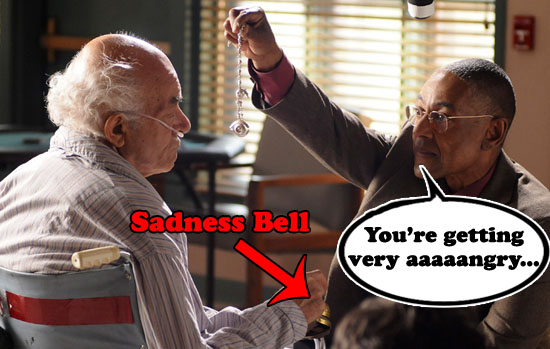
When Life Imitates TV – Hating the Real-Life Consequences
Of the many things written (including this early post on the movie industry’s response) about the devastating and terrible crimes committed by alleged shooter James Holmes in Aurora, Colorado, at last Friday morning’s midnight showing of Batman: The Dark Knight Rises, the things that tend not to be written (or reflected about) include the glee with which super-sized renderings of fictional violence, are received, when they’re stylish, when we can be convinced they’re not “real.”
Disclaimer: I love the show, Breaking Bad. The Daily Beast (Maria Elena Fernandez) in October 2011 wrote about whether the gory pyrotechnics of actor Giancarlo Esposito’s end as drug boss Gus Fring in the season 4 finale of the AMC-TV series Breaking Bad were really “necessary.” (Walking Dead special-effects crew spent “months” collaborating with Breaking Bad’s own crew on the sequence.)
And how! If you’re wondering if it was really necessary for Gilligan and his writers to blow Gus Fring’s face off, the answer is, Hell, yes! Not only was the manner of his demise surprising—death by bombing—but the end comes for Gus in a highly creative and artful way that ties together significant threads in the Breaking Bad saga. It also gives viewers a classic TV moment: Fring emerging from the blast on his feet, revealing he’s lost half his face, and then taking time to fix his tie, before finally collapsing.
Disclaimer number two: this post does not make any suggestion as to the media habits of the alleged killer, or the relationship between media and those events understood as deeds. Let me just say that design of Breaking Bad and all, chemist Walter White’s switch from cancer-diagnosed high-school teacher to psychopath capable of the most chilling acts of treachery as well as violence, somehow is not mitigating the sense that what we ask of our entertainment is to show the dehumanized human to us, more and more soulless.
Below is a picture of the 1966 Batmobile, a fond memory of the early Batman and Robin TV show. “Senseless violence” wasn’t a catchphrase then, or maybe I was too young to notice. I’m still left feeling really uncomfortable about victims at a midnight movie theater, because the implication of this seeming insanity is that we the dehumanized public share spaces in which we don’t even know who might act on us, and how. It is, as the character Owen Meany in John Irving’s book, A Prayer for Owen Meany, said MADE FOR TELEVISION.

